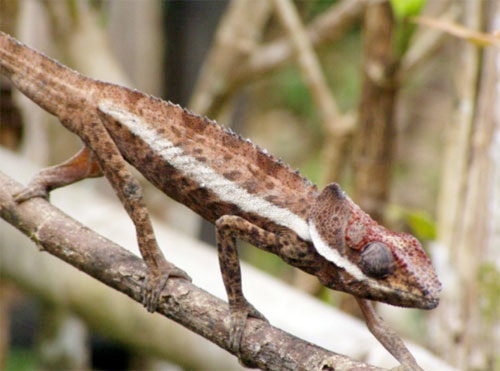



The grammatical gender of the genus Calumma
By Nicolà Lutzmann, PhD
Citation:
Lutzmann, N. (2005). The grammatical gender of the genus Calumma. Chameleons! Online E-Zine, February 2005. (http://www.chameleonnews.com/05FebAndersonWFTE.html)

Male Calumma cucullatum. Photo courtesy of Nicolà Lutzmann
The gender of a name of a genus is determined by the fact that it is based on either:
- a Latin word (then the gender is determined by the Latin language),
- a word of the Greek language taken over without changes (then the gender is determined by the Greek language) or
- a Latinised Greek word providing with Latin ending (then Latin ending applies). (art. 30,1-3.)
Also the genus name and the species name, if it concerns an adjective (e.g. cucullata, nasuta), must have the same gender according to the zoological nomenclature rules (art. 31.2.). If they are nouns (e.g. gallus, vatosoa) or named by persons (e.g. glawi, vencesi), they are independent from the gender of the name of the genus (art. 31.1.1-2 + 31.2.1).
In meetings and within private frameworks the gender of the genus Calumma was discussed again and again. With the revalidisation, KLAVER & BÖHME (1986) followed the feminine gender implied by GRAY 1865 (1864) (Calumma cucullata) and adapted according to the adjective species names. BÖHME communicated to me 1999 therefore, they had forgotten in this publication to adapt also the adjective (sub -) species names cristifer, globifer and furcifer. This was then published and used several times in non-scientific publications (LIECKFELD 2002, LUTZMANN 2000, 2004a + b).
However, already in 2003, KOBER draws the attention of a Greek word "kalymma" in the InterNet forum of the DGHT (http://www.dghtserver.de/foren/viewtopic.php?TopicID=10082#63555). The gender of this word is neutral. The meaning of this word is veil, coverage and, in addition, is used to describe the gill cover of fish. And if one examines the large occipital lopes of the type species of the genus C. cucullata, they do not seem dissimilar to gill covers.
Now the question is, was the word "kalymma" Latinised by GRAY (with change of "y" to "u") or is there actually a Latin word "calumma" and if so, which gender is it in Latin. If GRAY Latinised the word "calumma", then it would have had the gender of the Latin ending (- a = feminine) or that, which GRAY wanted to give by the new combination.
At approximately the same time the results of two teams of authors were published (LUTZMANN & LUTZMANN 2004 a+b, WALBRÖL & WALBRÖL 2004). Both teams have the same result: The genus name Calumma has to be acted as a neuter noun, but the justification is different. Walbröl & Walbröl assume that Gray took the Greek word "kalymma" and simply Latinised it. LUTZMANN & LUTZMANN, however, have found in different sources the Latin word "calumma, - atis" - a neutral gender (GEORGES 1959, WHITAKER 2004). According to the justification of WALBRÖL & WALBRÖL the genus Calumma would have to be acted as feminine, but since there is actually a Latin word - although rarely used - the gender of the genus has to be neutral.
With both author teams, an error occurred when changing the (sub -) species names. They overlooked an article in the zoological nomenclature rules (art. 31.2.2) (Glaw in prep). This article describes, among other things, how species names, which end in -fer or -ger, have to be treated: If the describer did not expressly determined the fact that they are to be treated as adjectives, they have to be treated as nouns, i.e. they do not have to agree with the gender of the generic name. As a result, the changes to C. p. cristiferum, C. globiferum and C. furciferum must be cancelled.
A current list of the valid Taxa of the genus Calumma GRAY, 1865 (1864):
Calumma andringitraense (BRYGOO, BLANC, DOMERGUE, 1974)
Calumma boettgeri (BOULENGER, 1888)
Calumma brevicorne brevicorne (GÜNTHER, 1879)
Calumma brevicorne tsarafidyi (BRYGOO & DOMERGUE, 1970)
Calumma capuroni (BRYGOO, BLANC & DOMERGUE, 1972)
Calumma cucullatum (GRAY, 1831)
Calumma fallax (MOCQUARD, 1900)
Calumma furcifer (VAILLANT & GRANDIDIER, 1880)
Calumma gallus (GÜNTHER, 1877)
Calumma gastrotaenia (BOULENGER, 1888)
Calumma guillaumeti (BRYGOO, BLANC & DOMERGUE, 1974)
Calumma glawi (BÖHME, 1997)
Calumma globifer (GÜNTHER, 1879)
Calumma guibei (HILLENIUS, 1959)
Calumma hilleniusi (BRYGOO, BLANC & DOMERGUE, 1973)
Calumma linotum (MÜLLER, 1924)
Calumma malthe (GÜNTHER, 1979)
Calumma marojezense (BRYGOO, BLANC & DOMERGUE, 1970)
Calumma nasutum (DUMÉRIL & BIBRON, 1836)
Calumma oshaughnessyi oshaughnessyi (GÜNTHER, 1911)
Calumma oshaughnessyi ambreense (RAMANANTSOA, 1974)
Calumma parsonii parsonii (CUVIER, 1824)
Calumma parsonii cristifer (METHUEN & HEWITT, 1913)
Calumma peyrierasi (BRYGOO, BLANC & DOMERGUE, 1974)
Calumma tigris (KUHL, 1820)
Calumma tsaratananense (BRYGOO & DOMERGUE, 1968)
Calumma vatosoa (ANDREONE, MATTIOLI, JESU & RANDRIANIRINA, 2001)
Calumma vencesi (ANDREONE, MATTIOLI, JESU & RANDRIANIRINA, 2001)

Nicolà Lutzmann, PhD

Nicolà Lutzmann keeps chameleons since he was 15 years old. His first species was Ch. chamaeleon from Israel. In the last 14 years he bred about 16 species, some into the fourth generation. In 1997 he starts to study biology in Heidelberg, Germany and he finished in 2002 with the diploma thesis “Investigations about the distribution, systematic and ecology of the chameleon-fauna of Egypt” in Bonn (Museum Koenig), Germany. He finished his PhD with the title "Investigations on the ecology of the chameleon fauna of the Masoala peninsular, NE Madagascar" and works now for a pesticide risk assessment company and as a voluntary freelancer at the Museum Koing in Bonn. namaquensis@gmx.de









Join Our Facebook Page for Updates on New Issues:
© 2002-2014 Chameleonnews.com All rights reserved.
Reproduction in whole or part expressly forbidden without permission from the publisher. For permission, please contact the editor at editor@chameleonnews.com
